From Beijing through Mongolia to Moscow, New Orleans-based artist and author Emma Fick illustrates her journey on the Trans-Siberian Railway in watercolors.
This interview has been edited for length and clarity.
KCRW: What is the Trans Siberian Railway?
Emma Fick: It is the longest railway in the world. It actually has three routes, which a lot of people don't know, there's the one that you mentioned from Moscow to Vladivostok. And then there's one it's called the trans Manchurian, and then there's the trans Mongolian and both of those terminate in Beijing.
How many days, how many cities, how many miles was your trip?
If you'd never get off the train, it's six to seven full days on the train day and night. But we knew that we wanted to make quite a few stopovers, so we ended up stopping in seven cities if you count the beginning and the end. It was actually supposed to be eight. But there was a small mishap in the middle of our trip, which meant that we got behind schedule and had to knock out one of our stops.
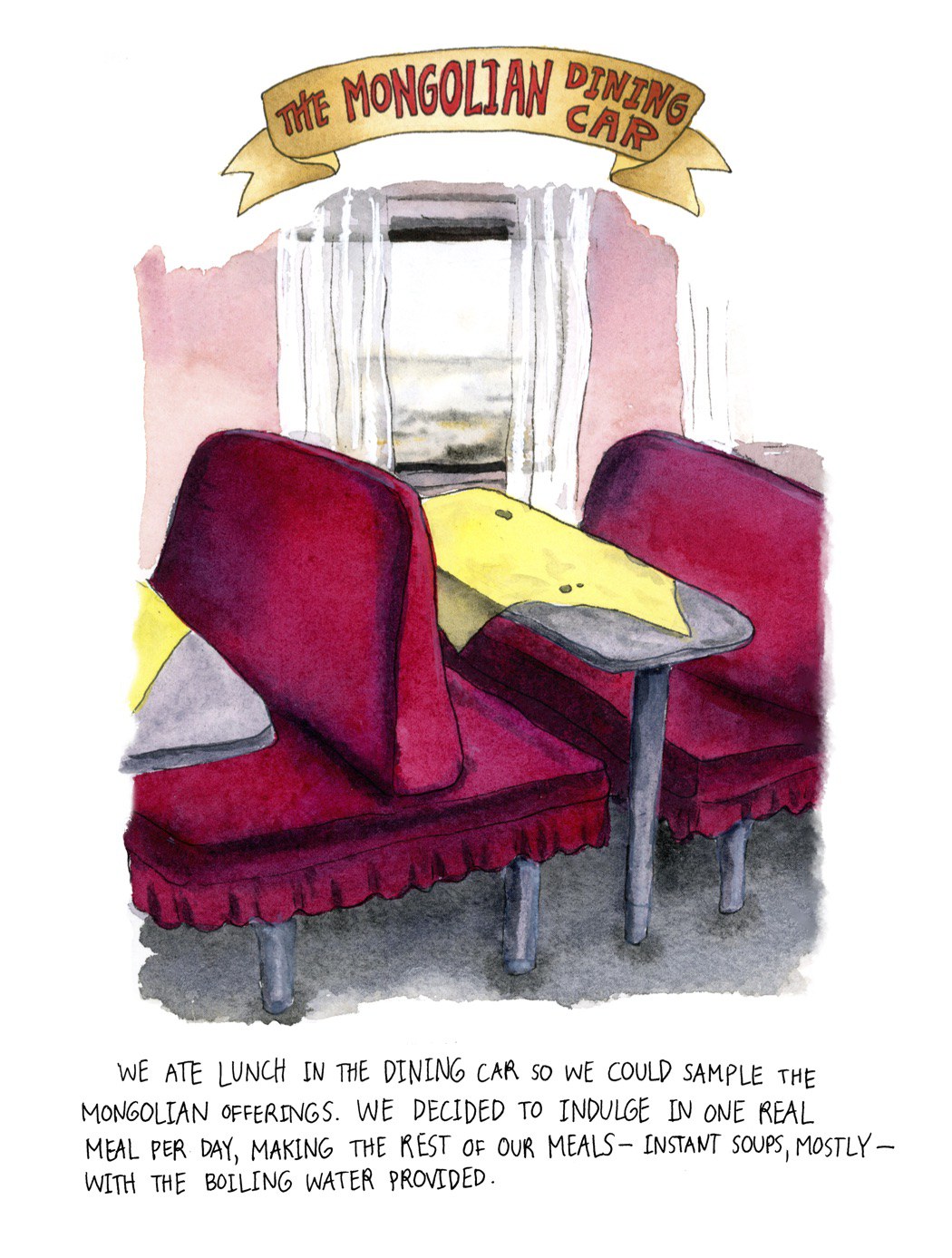
Dining cars, located at the end of the train, are swapped out in each country. Illustration by Emma Fick.
What was the longest amount of time you were on the train without a stop?
It was 38 hours. We could have made a lot more stops than we did. There is no singular Trans Siberian Railway experience. And this is where you really start to see that and that what kind of trip you have is really going to depend on how many stops you make. Some people want to take it from start to finish to really feel that seven, full days on the train when you enter this time warp. And we knew that we wanted a little bit of a time warp. We didn't want to get off so often that we were only spending 12 hours on the train at a time. So our longest single stay on the train was 38 hours. And I think passing that 24 hour mark and then some really gave us some of that time warp feeling that everyone talks about when they talk about this journey.
Read the portion from the top of page 33 for me.
“We found ourselves sinking deeper and deeper into a train robbery punctuated by train stops. Time became fluid and hours ran by quickly as we were lulled into some alternate universe by the rocking train and the wide landscape gliding past us through the window. The train cabins were warm, cozy and content even in short sleeves, we remained transfixed by the view outside the window, leaving the books and our backpacks untouched.”
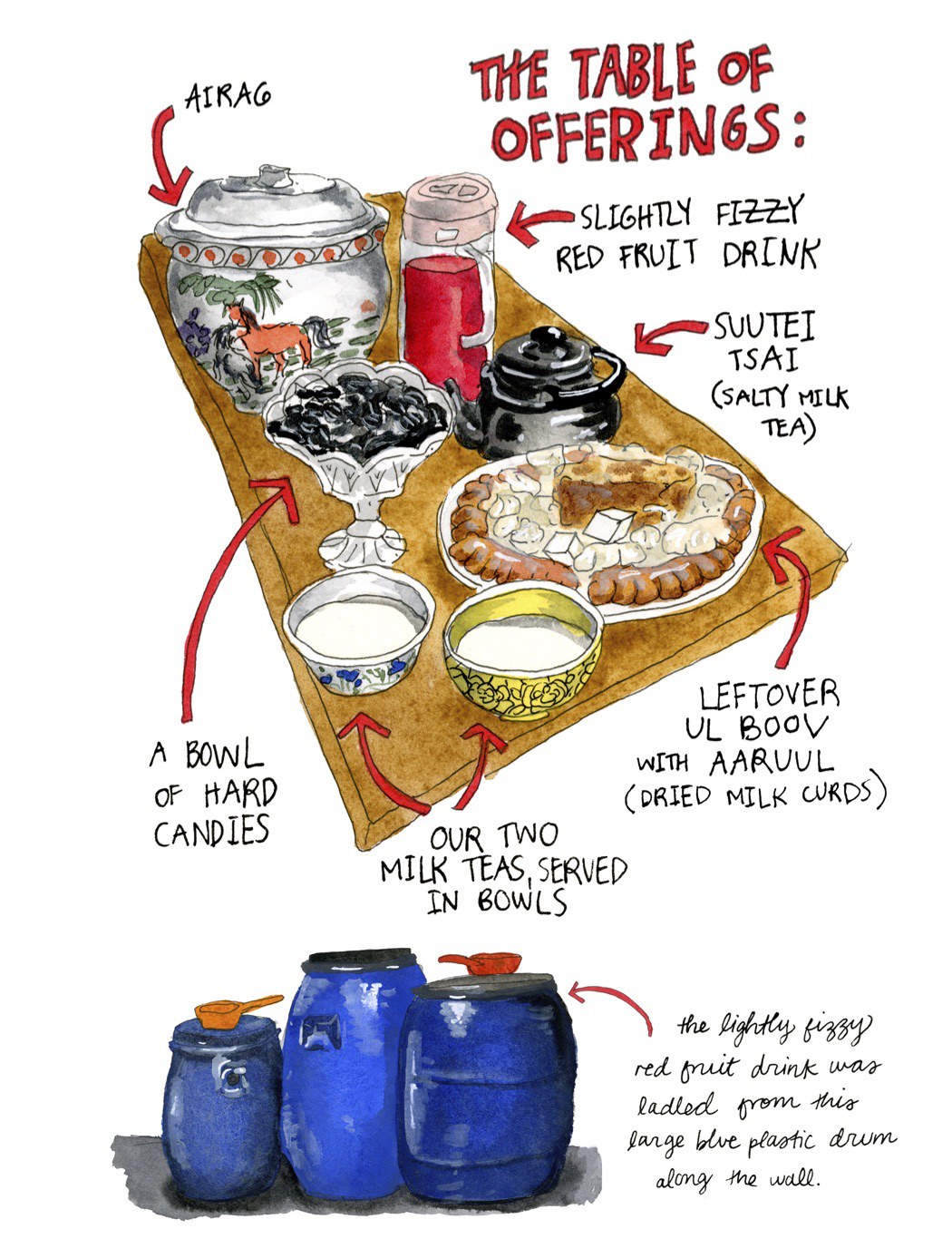
Among nomads, no money is exchanged for lodging. But Emma Fick and her husband, Helvio, were presented with offerings that included airag, a fermented mare's milk, and ul boov, made of layers of fried cakes with dried milk curds and topped with sugar cubes. Illustration by Emma Fick.
You talked about how even before leaving on the trip, you experienced profound longing and even nostalgia for it, even though you had never been. What do you think there is about this particular railway and the route that causes this type of feeling?
I think with any mythologized journey, there is a way in which I, as someone who had never been on the trip, felt like I'd been on it many times just by reading other people's accounts and looking at pictures. And so as you're anticipating the trip, you're also feeling as though you're remembering the trip. It's a very strange duality of feeling.
Tell us a story of your husband finding a particular book in a thrift shop that jump started this journey for the two of you.
I love this story. We were in Helsinki, Finland, and I'm an avid thrift store shopper, and I was in a thrift store spending too long looking at scarves and dishes that I obviously couldn't take with me. And he's a very patient man. He just stood by the books and was looking through them. When I went to the register to pay, he came up and said, ‘Hey, can you get this, too.’ And I was surprised because he was never asked to get anything when I'm on one of my thrift rampages. And it was the Trans Siberian handbook that we ended up taking with us on the trip. I looked at it, and I looked at him and he said, ‘This has been my dream since I was a boy in Brazil.’
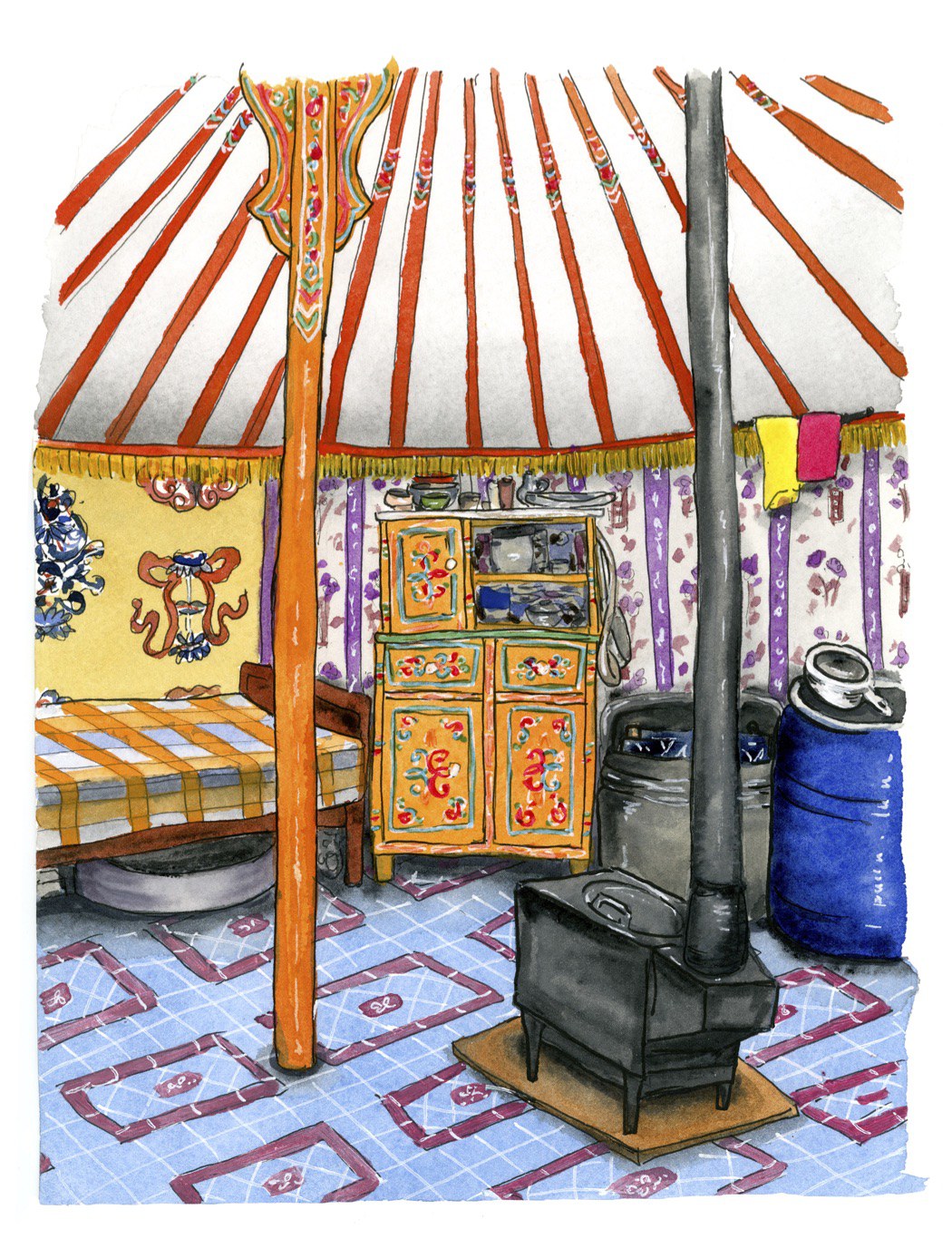
Fick depicts the setting of her dinner with nomads at one stop, where she shared a meal of thick-cut homemade noodles with bits of mutton while sitting in a "ger," a type of yurt. Illustration by Emma Fick.
Let's talk a bit just about the railway. Who created it, and why was it created?
The short answer is that Siberia before the Trans Siberian Railway was really not accessible. I mean, it still has the reputation of being this desolate landscape where you send prisoners to suffer and work and maybe die in obscurity. And it had that reputation for a reason the railway made it possible to populate this vast portion of Russia that previously had not been able to have any population or any functioning cities. It allowed Russia to move huge quantities of its resources from one end to another and then to get them to other parts of the world. So it was both a military and economic stronghold for Russia. And it was incredibly important in establishing its dominance on the world stage.
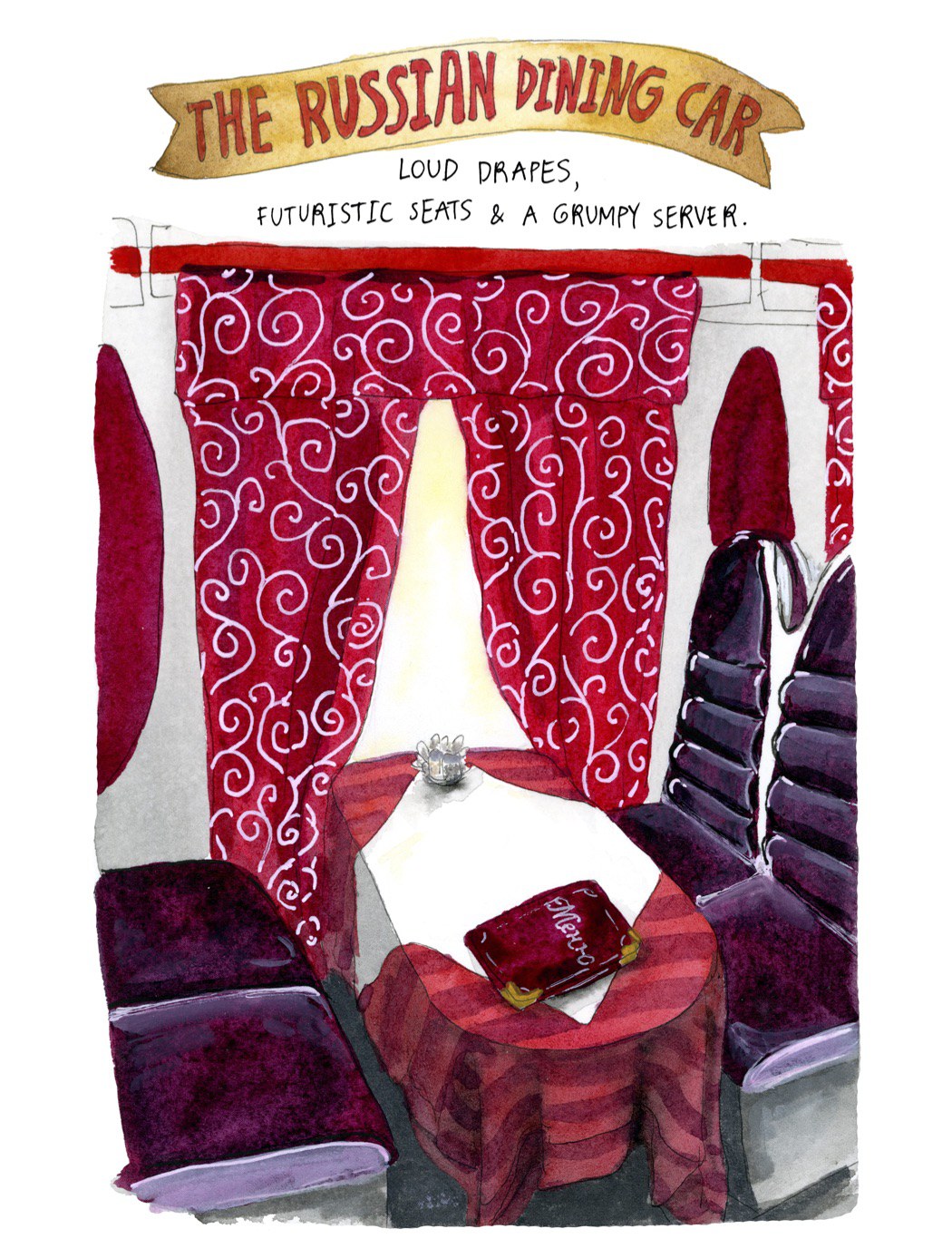
Fick traveled second class on a frugal budget but splurged in the Russian dining car, which she describes as a "futuristic, Space Shuttle scene" with vinyl seats and wild swirls on the curtains. Illustration by Emma Fick.
Today, is it just a fantasy ride or does the railway still fulfill a practical purpose?
Not at all. I would say that it is really only a fantasy ride for foreigners. It still transports a huge amount of industrial product and people take it just as you would take a bus or an airplane.
What did you pack to bring? I'm so curious about what turned out to be the greatest comfort in the stuff that you brought along.
We had done quite a bit of research on the food to bring because it's pretty daunting to be stuck for a day or two, and have to eat out of your backpack. The main thing is that you have access to a hot water heater. When I say hot water, I mean it comes out boiling. But the value of that burning hot water is that you can make instant noodles. I would say that was the biggest comfort because after 12-14-20 hours, you get a little bit sick of the cold food, and making those noodles turned out to be a lifesaver.

The literal translation of "stolovaya" is "canteen" but Fick thought of it more as a cafeteria where she discovered the Russian dish, "Herring Under a Fur Coat." Illustration by Emma Fick.
Now we should say that you were traveling in second class, and you're frugal. So many people may have had a million meals in the dining car. But you chose not to talk about a few of your dining car experiences and how different they were from dining car to dining car as that car actually changed throughout the voyage.
Yes, the dining cars were one of my favorite parts of the train journey. I will say I'm frugal, but not so frugal that I will deny myself and experience. So our decision was that every train we were on, we would eat in the dining car once. The dining cars are changed according to the country. So when you cross the border from Mongolia, to China, for example, they take off the Mongolia dining car and put on the Chinese dining car. And for that reason, it's always at the end of the train. But it also depends on which train you're on. There all these different numbers of the train. Not every dining car across every line is the same. So I ate at one Chinese dining car, one Russian one and one Mongolian one, but there are so many others that I didn't get a chance to try. The decor in each is fantastic. And one of my favorite parts the Russian dining car looked like some futuristic Space Shuttle scene – it had these vinyl seats in this deep maroon reddish color, and these wild swirls on the curtains. The Chinese dining car that we were in looked like a classic diner, it looked more like something you would walk into not on a train. The Mongolian dining car had the brightest bright pink and yellow clashing tablecloths and curtains that I've ever seen. So it's very, it's like walking into a little universe when you walk back and enter that dining car. And we tried to order in each car, something that was classic or traditional to the country that the dining car belonged to. So we got borscht in the Russian dining car. The Russian one was our least favorite. Even though I love Russian food, we got a fermented bean chicken dish in the Chinese dining car. And the Chinese dining car was our favorite. It was morning when we ate in the Mongolian dining car. So I feel like I didn't give it a fair shot because we just got an omelet, and who can tell anything from an omelet?

"I think with any mythologized journey, there is a way in which I, who had never been on the trip, felt like I had been on it many times just by reading other people's accounts," says New Orleans-based artist Emma Fick. "As you're anticipating the trip, you're also feeling as if you're remembering the trip." Photo by Sarah Becker.
So you finally crossed the border into Russia and you left the train again in Irkutsk. Tell us about the market there.
I loved that market. There were all of these stalls. And like a lot of markets. It's divided by sections. There's the meat section, the fish section, the caviar section, the biscuit section. But this market had one of the best biscuit sections I've ever seen in my life. And I'm kind of a biscuit connoisseur, I would say because every country almost has its version of like the snack biscuit you take in your bag with you. I almost always stop and get whatever that country has to offer. So when I went to this market and Irkutsk and saw that, they had these stalls that were stuffed to the brim, they were almost like glass boxes, and they were just piled floor to ceiling pushed up against the glass with hundreds of different types of tea biscuits. My head started spinning around, I just lost my mind.
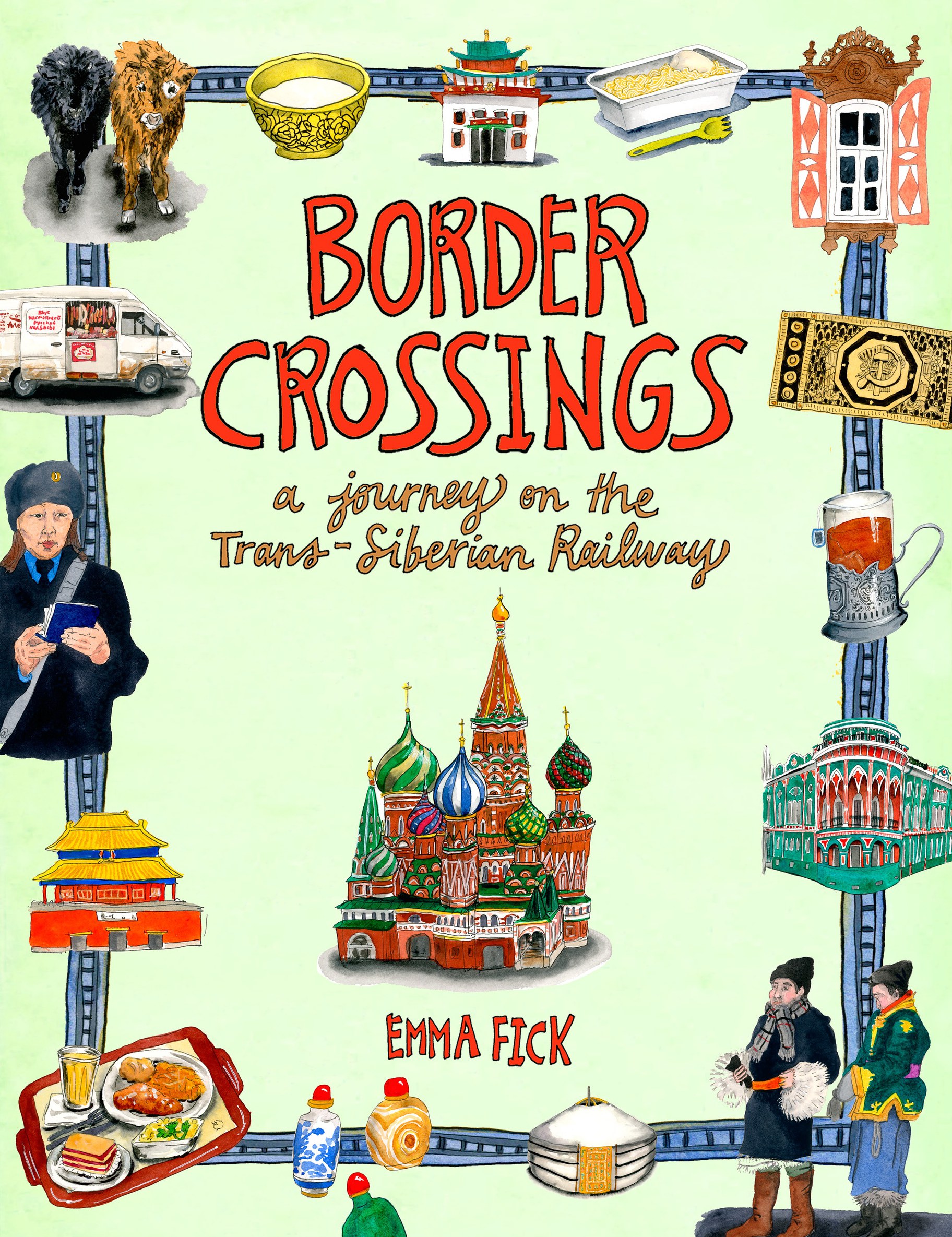
Emma Fick stopped in seven cities and spent a 38-hour stretch on the Trans-Siberian Railway, documenting her journey in "Border Crossings." Photo courtesy of Harper Design.
You took this trip in 2017. And with the war in Ukraine happening in the reverberations surrounding Russia, you must have some thoughts on having been able to take this trip, and the increased difficulty to do it.
I do. And I will also say just first of all, I have lived and traveled in a lot of places that have extremely vicious and problematic and awful governments. And actually, as a citizen of the U.S., I consider myself to live in one of those places and also someone who lives in the South. I identify with that. And so I have always kept a firm differentiation between the people of a place and their government. I mean, I know all too well how it feels to have a government that you feel does not represent you. So I still feel so much tenderness towards the Russian people and towards the cultures that I got to experience with them. So I just wanted to start by saying that, and then you're absolutely right. When I started on this book, which was in 2019, I imagined that it would be something that people could read and then take in their hands with them on the trip. And now it looks like it'll be more of a time capsule because I am not sure when the Russian border will be open, especially for Americans, it might be a decade. So originally, I thought that this would be a book you could take with you on the trip. And now I think this book might be the only way to take the trip itself.
